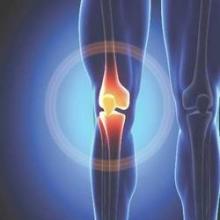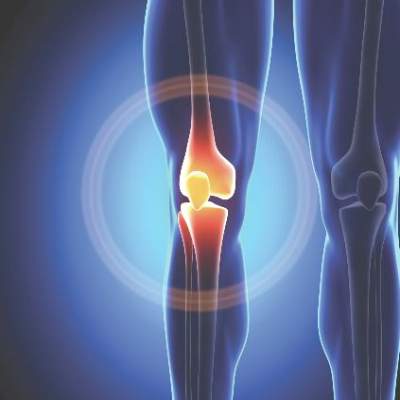User login
Serum concentration of hyaluronic acid correlated with the severity of knee osteoarthritis in a longitudinal population-based cohort, with concentrations above 51.9 ng/mL significantly associated with progression in people with moderate disease.
While previous studies have suggested cutoff values for serum hyaluronic acid (HA) as biomarkers for progression of knee osteoarthritis, this study, conducted by Dr. Eiji Sasaki of Hirosaki (Japan) University and his colleagues, is the first to report a serum HA cutoff value from a longitudinal study.
The investigators prospectively enrolled 720 volunteers into a community-based preventive medicine program with intent to follow them for 5 years. They excluded patients with renal failure, liver failure, rheumatoid arthritis, or cancer, as all of these can increase serum HA. HA concentrations and knee radiography were taken at baseline and at 5-year follow-up, with complete data from 444 patients (mean age 55, 64% female) entered into analysis. Dr. Sasaki and his colleagues measured severity of knee osteoarthritis using Kellgren-Lawrence grades. Higher serum HA at baseline correlated with KL grade progression in the cohort as a whole (P = .004), and HA concentration was linked to joint space narrowing in knees with no disease or mild disease (KL grades 0-1) and moderate disease (KL grades 2 or 3) at baseline (P = .021 and P = .008, respectively).
Serum HA of 51.9 ng/mL was predictive of knee osteoarthritis progression in subjects (n = 119) with KL grades 2 or 3 disease (area under curve [AUC], 0.707), and associated with a fivefold increase (odds ratio, 4.89) in risk of joint space narrowing over 5 years. For people with mild or no disease at baseline (n = 323), Dr. Sasaki and his colleagues identified a cutoff of 35.1 ng/mL for the development of OA, but it was not a robust indicator with an AUC of 0.603 (Arthritis Res Ther. 2015;17:283. doi: 10.1186/s13075-015-0793-0).
“Further clinical studies are needed to determine whether serum HA can predict the incidence of OA, which was not determined in the present study,” Dr. Sasaki and his colleagues wrote in their analysis. They noted that the cutoff value of 51.9 ng/mL “should be useful during screening for abnormal knee conditions or as an additional evaluation for the risk of OA progression when used in combination with conventional imaging tools.”
The study was funded by grants from the Japanese government, the Japanese Society for the Promotion of Science, and the Japanese Orthopedic Association. Dr. Sasaki and colleagues declared no conflicts of interest.
Serum concentration of hyaluronic acid correlated with the severity of knee osteoarthritis in a longitudinal population-based cohort, with concentrations above 51.9 ng/mL significantly associated with progression in people with moderate disease.
While previous studies have suggested cutoff values for serum hyaluronic acid (HA) as biomarkers for progression of knee osteoarthritis, this study, conducted by Dr. Eiji Sasaki of Hirosaki (Japan) University and his colleagues, is the first to report a serum HA cutoff value from a longitudinal study.
The investigators prospectively enrolled 720 volunteers into a community-based preventive medicine program with intent to follow them for 5 years. They excluded patients with renal failure, liver failure, rheumatoid arthritis, or cancer, as all of these can increase serum HA. HA concentrations and knee radiography were taken at baseline and at 5-year follow-up, with complete data from 444 patients (mean age 55, 64% female) entered into analysis. Dr. Sasaki and his colleagues measured severity of knee osteoarthritis using Kellgren-Lawrence grades. Higher serum HA at baseline correlated with KL grade progression in the cohort as a whole (P = .004), and HA concentration was linked to joint space narrowing in knees with no disease or mild disease (KL grades 0-1) and moderate disease (KL grades 2 or 3) at baseline (P = .021 and P = .008, respectively).
Serum HA of 51.9 ng/mL was predictive of knee osteoarthritis progression in subjects (n = 119) with KL grades 2 or 3 disease (area under curve [AUC], 0.707), and associated with a fivefold increase (odds ratio, 4.89) in risk of joint space narrowing over 5 years. For people with mild or no disease at baseline (n = 323), Dr. Sasaki and his colleagues identified a cutoff of 35.1 ng/mL for the development of OA, but it was not a robust indicator with an AUC of 0.603 (Arthritis Res Ther. 2015;17:283. doi: 10.1186/s13075-015-0793-0).
“Further clinical studies are needed to determine whether serum HA can predict the incidence of OA, which was not determined in the present study,” Dr. Sasaki and his colleagues wrote in their analysis. They noted that the cutoff value of 51.9 ng/mL “should be useful during screening for abnormal knee conditions or as an additional evaluation for the risk of OA progression when used in combination with conventional imaging tools.”
The study was funded by grants from the Japanese government, the Japanese Society for the Promotion of Science, and the Japanese Orthopedic Association. Dr. Sasaki and colleagues declared no conflicts of interest.
Serum concentration of hyaluronic acid correlated with the severity of knee osteoarthritis in a longitudinal population-based cohort, with concentrations above 51.9 ng/mL significantly associated with progression in people with moderate disease.
While previous studies have suggested cutoff values for serum hyaluronic acid (HA) as biomarkers for progression of knee osteoarthritis, this study, conducted by Dr. Eiji Sasaki of Hirosaki (Japan) University and his colleagues, is the first to report a serum HA cutoff value from a longitudinal study.
The investigators prospectively enrolled 720 volunteers into a community-based preventive medicine program with intent to follow them for 5 years. They excluded patients with renal failure, liver failure, rheumatoid arthritis, or cancer, as all of these can increase serum HA. HA concentrations and knee radiography were taken at baseline and at 5-year follow-up, with complete data from 444 patients (mean age 55, 64% female) entered into analysis. Dr. Sasaki and his colleagues measured severity of knee osteoarthritis using Kellgren-Lawrence grades. Higher serum HA at baseline correlated with KL grade progression in the cohort as a whole (P = .004), and HA concentration was linked to joint space narrowing in knees with no disease or mild disease (KL grades 0-1) and moderate disease (KL grades 2 or 3) at baseline (P = .021 and P = .008, respectively).
Serum HA of 51.9 ng/mL was predictive of knee osteoarthritis progression in subjects (n = 119) with KL grades 2 or 3 disease (area under curve [AUC], 0.707), and associated with a fivefold increase (odds ratio, 4.89) in risk of joint space narrowing over 5 years. For people with mild or no disease at baseline (n = 323), Dr. Sasaki and his colleagues identified a cutoff of 35.1 ng/mL for the development of OA, but it was not a robust indicator with an AUC of 0.603 (Arthritis Res Ther. 2015;17:283. doi: 10.1186/s13075-015-0793-0).
“Further clinical studies are needed to determine whether serum HA can predict the incidence of OA, which was not determined in the present study,” Dr. Sasaki and his colleagues wrote in their analysis. They noted that the cutoff value of 51.9 ng/mL “should be useful during screening for abnormal knee conditions or as an additional evaluation for the risk of OA progression when used in combination with conventional imaging tools.”
The study was funded by grants from the Japanese government, the Japanese Society for the Promotion of Science, and the Japanese Orthopedic Association. Dr. Sasaki and colleagues declared no conflicts of interest.
FROM ARTHRITIS RESEARCH & THERAPY
Key clinical point: Serum HA of 51.9 ng/mL predicts a fivefold increase in risk of progression of existing knee osteoarthritis over 5 years.
Major Finding: Higher sHA concentration was positively correlated with progression of joint space narrowing in people with none-to-mild (P = .021) and moderate (P = .008) knee OA at baseline. Higher concentrations correlated with OA progression as measured by Kellgren-Lawrence grades (P = .004).
Data source: A population-based cohort of 866 people from a community in Japan; 444 subjects received knee radiography and serum HA analysis at baseline and 5-year follow-up.
Disclosures: The study was funded by government and foundation grants in Japan; the investigators disclosed no conflicts of interest.

